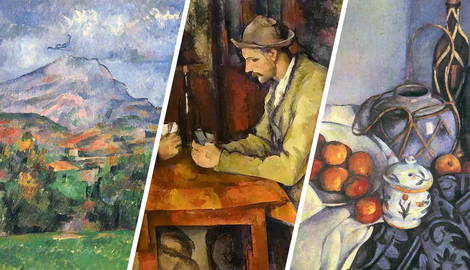
Widely recognized today as the ‘Father of Modern Art,’ French post-impressionist painter Paul Cezanne made some of the most monumental artworks of the late 19th and early 20th century. He took the fresh, en plein air vibrancy of Impressionism in a bold new direction, exploring how real-life objects and places could be deconstructed into faceted, structural planes. But perhaps most radical was his exploration into multiple perspective within a single image, opening up questions about the nature of perception, which went on to shape the Cubist art of Georges Braque and Pablo Picasso. Below, we take a look through Cezanne’s most ground-breaking paintings, many of which were made towards the latter part of his career.
1. The Gulf of Marseille Seen from L’Estaque, 1885

From the 1870s onwards, Cezanne made at least 20 paintings in the French fishing village of L’Estaque. They mark a pivotal moment in his life, when he moved away from the somber tones and macabre subject matter of his earlier Parisian paintings to a lighter, brighter, impressionistic touch, under the tutelage of his mentor and elder Camille Pissarro. Cezanne was fascinated by the brilliant light he encountered in L’Estaque, along with the structured patterns of the houses scattered along the shoreline, which became abstracted, geometric shapes in his mind’s eye. In a letter to Pissarro in 1876, Cezanne wrote, “It is like a playing card. Red roofs over the blue sea… The sun is so terrific here that it seems to me as if the objects were silhouetted not only in black and white, but in blue, red, brown, and violet.”
2. The Card Players, 1890-95

This painting is one of a series of five, made over several years, which Cezanne based on the subject of card players engrossed in an intimate game. In each painting the men are situated in an earthy, dimly-lit interior space, demonstrating a still, contemplative fortitude. This particular version shows just two players who face one another with quiet determination, as their rugged, expressively-painted clothes seem to become one with the rustic surroundings. Cezanne made a series of figure studies based on farm hands in Provence for the ‘Card Players’ paintings, and the group of paintings demonstrate his determined desire to fine tune the subject, through playing with composition and lighting effects until he reached the most pleasing balance.
3. Still Life with Apples, 1893-4

Still life subjects were a recurring theme in Cezanne’s art throughout his career, and their static, unmoving nature became the ideal subject for Cezanne to explore the way the human eye roves over objects and takes them in at multiple perspectival points, rather than as a photographic snapshot. He also came to have a cast of recurring subjects within his still life paintings, many of which can be seen here, including a rum bottle, green vase, and an assortment of apples tumbling out across a tabletop. This painting demonstrates Cezanne’s masterful, lively, and imaginative exploration of still life, with objects that seem to shift and move in space, and a crinkled, creviced tablecloth that resembles the craggy surface of a mountaintop.
4. Montagne Saint-Victoire, 1890

Cezanne was transfixed by Montagne Saint-Victoire, near his home town of Aix-en-Provence, and he dedicated the latter part of his life to painting its distinctive, low-lying profile from differing perspectives and in various weather conditions. Throughout his life he made more than 80 paintings and studies of the mountain directly from life, often trekking out in poor weather to examine its ever-shifting surface with deep fascination. This version demonstrates the artist’s increasingly abstract painterly language, with scattered, pattern-like brushstrokes and bare patches of canvas left showing.
5. The Large Bathers (Les Grandes Baigneuses), 1894-1905

Along with painting Montagne Sainte-Victoire, Cezanne spent the last decade of his life working on his ‘Bathers’, a group of monumental paintings depicting fictional, fantastical reclining nudes within a lush forest. This particular painting is one of the best known in the series, and now belongs to the Barnes Collection. Cezanne’s ‘Bathers’ veer closer to abstraction than any of his other artworks, forgoing real world subjects for an imaginative interplay of shape, form, structure and design. Yet they retain the same blue and ochre color schemes as his Provencal landscapes, representing his enduring fascination with the spatial, structural, and atmospheric possibilities of nature.











